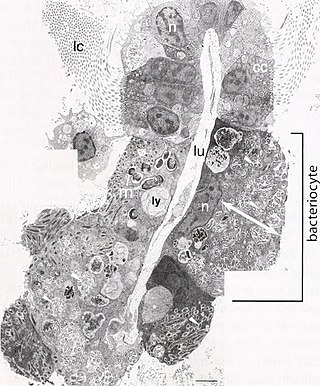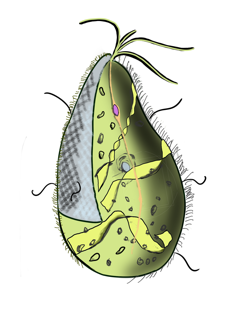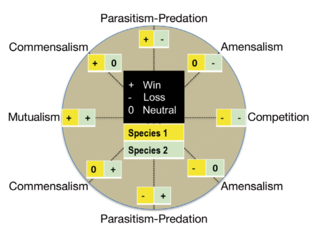Related Research Articles

An endosymbiont or endobiont is any organism that lives within the body or cells of another organism most often, though not always, in a mutualistic relationship. This phenomenon is known as endosymbiosis. Examples are nitrogen-fixing bacteria, which live in the root nodules of legumes, single-cell algae inside reef-building corals and bacterial endosymbionts that provide essential nutrients to insects.

Symbiosis is any type of a close and long-term biological interaction between two biological organisms of different species, termed symbionts, be it mutualistic, commensalistic, or parasitic. In 1879, Heinrich Anton de Bary defined it as "the living together of unlike organisms". The term is sometimes used in the more restricted sense of a mutually beneficial interaction in which both symbionts contribute to each other's support.

In biology and medicine, a host is a larger organism that harbours a smaller organism; whether a parasitic, a mutualistic, or a commensalist guest (symbiont). The guest is typically provided with nourishment and shelter. Examples include animals playing host to parasitic worms, cells harbouring pathogenic (disease-causing) viruses, or a bean plant hosting mutualistic (helpful) nitrogen-fixing bacteria. More specifically in botany, a host plant supplies food resources to micropredators, which have an evolutionarily stable relationship with their hosts similar to ectoparasitism. The host range is the collection of hosts that an organism can use as a partner.

Rhizobia are diazotrophic bacteria that fix nitrogen after becoming established inside the root nodules of legumes (Fabaceae). To express genes for nitrogen fixation, rhizobia require a plant host; they cannot independently fix nitrogen. In general, they are gram negative, motile, non-sporulating rods.
Diazotrophs are bacteria and archaea that fix atmospheric nitrogen(N2) in the atmosphere into bioavailable forms such as ammonia.

Root nodules are found on the roots of plants, primarily legumes, that form a symbiosis with nitrogen-fixing bacteria. Under nitrogen-limiting conditions, capable plants form a symbiotic relationship with a host-specific strain of bacteria known as rhizobia. This process has evolved multiple times within the legumes, as well as in other species found within the Rosid clade. Legume crops include beans, peas, and soybeans.

Nod factors, are signaling molecules produced by soil bacteria known as rhizobia in response to flavonoid exudation from plants under nitrogen limited conditions. Nod factors initiate the establishment of a symbiotic relationship between legumes and rhizobia by inducing nodulation. Nod factors produce the differentiation of plant tissue in root hairs into nodules where the bacteria reside and are able to fix nitrogen from the atmosphere for the plant in exchange for photosynthates and the appropriate environment for nitrogen fixation. One of the most important features provided by the plant in this symbiosis is the production of leghemoglobin, which maintains the oxygen concentration low and prevents the inhibition of nitrogenase activity.

Buchnera aphidicola, a member of the Pseudomonadota and the only species in the genus Buchnera, is the primary endosymbiont of aphids, and has been studied in the pea aphid, Acyrthosiphon pisum. Buchnera is believed to have had a free-living, Gram-negative ancestor similar to a modern Enterobacterales, such as Escherichia coli. Buchnera is 3 µm in diameter and has some of the key characteristics of its Enterobacterales relatives, such as a Gram-negative cell wall. However, unlike most other Gram-negative bacteria, Buchnera lacks the genes to produce lipopolysaccharides for its outer membrane. The long association with aphids and the limitation of crossover events due to strictly vertical transmission has seen the deletion of genes required for anaerobic respiration, the synthesis of amino sugars, fatty acids, phospholipids, and complex carbohydrates. This has resulted not only in one of the smallest known genomes of any living organism, but also one of the most genetically stable.

Aposymbiosis occurs when symbiotic organisms live apart from one another. Studies have shown that the lifecycles of both the host and the symbiont are affected in some way, usually negative, and that for obligate symbiosis the effects can be drastic. Aposymbiosis is distinct from exsymbiosis, which occurs when organisms are recently separated from a symbiotic association. Because symbionts can be vertically transmitted from parent to offspring or horizontally transmitted from the environment, the presence of an aposymbiotic state suggests that transmission of the symbiont is horizontal. A classical example of a symbiotic relationship with an aposymbiotic state is the Hawaiian bobtail squid Euprymna scolopes and the bioluminescent bacteria Vibrio fischeri. While the nocturnal squid hunts, the bacteria emit light of similar intensity of the moon which camouflages the squid from predators. Juveniles are colonized within hours of hatching and Vibrio must outcompete other bacteria in the seawater through a system of recognition and infection.

A bacteriocyte, also known as a mycetocyte, is a specialized adipocyte found primarily in certain insect groups such as aphids, tsetse flies, German cockroaches, weevils. These cells contain endosymbiotic organisms such as bacteria and fungi, which provide essential amino acids and other chemicals to their host. Bacteriocytes may aggregate into a specialized organ called the bacteriome.

Mixotricha paradoxa is a species of protozoan that lives inside the gut of the Australian termite species Mastotermes darwiniensis.
Horizontal transmission is the transmission of organisms between biotic and/or abiotic members of an ecosystem that are not in a parent-progeny relationship. This concept has been generalized to include transmissions of infectious agents, symbionts, and cultural traits between humans.

Trichonympha is a genus of single-celled, anaerobic parabasalids of the order Hypermastigia that is found exclusively in the hindgut of lower termites and wood roaches. Trichonympha’s bell shape and thousands of flagella make it an easily recognizable cell. The symbiosis between lower termites/wood roaches and Trichonympha is highly beneficial to both parties: Trichonympha helps its host digest cellulose and in return receives a constant supply of food and shelter. Trichonympha also has a variety of bacterial symbionts that are involved in sugar metabolism and nitrogen fixation.
Actinorhizal plants are a group of angiosperms characterized by their ability to form a symbiosis with the nitrogen fixing actinomycetota Frankia. This association leads to the formation of nitrogen-fixing root nodules.
Cyanobionts are cyanobacteria that live in symbiosis with a wide range of organisms such as terrestrial or aquatic plants; as well as, algal and fungal species. They can reside within extracellular or intracellular structures of the host. In order for a cyanobacterium to successfully form a symbiotic relationship, it must be able to exchange signals with the host, overcome defense mounted by the host, be capable of hormogonia formation, chemotaxis, heterocyst formation, as well as possess adequate resilience to reside in host tissue which may present extreme conditions, such as low oxygen levels, and/or acidic mucilage. The most well-known plant-associated cyanobionts belong to the genus Nostoc. With the ability to differentiate into several cell types that have various functions, members of the genus Nostoc have the morphological plasticity, flexibility and adaptability to adjust to a wide range of environmental conditions, contributing to its high capacity to form symbiotic relationships with other organisms. Several cyanobionts involved with fungi and marine organisms also belong to the genera Richelia, Calothrix, Synechocystis, Aphanocapsa and Anabaena, as well as the species Oscillatoria spongeliae. Although there are many documented symbioses between cyanobacteria and marine organisms, little is known about the nature of many of these symbioses. The possibility of discovering more novel symbiotic relationships is apparent from preliminary microscopic observations.
The hologenome theory of evolution recasts the individual animal or plant as a community or a "holobiont" – the host plus all of its symbiotic microbes. Consequently, the collective genomes of the holobiont form a "hologenome". Holobionts and hologenomes are structural entities that replace misnomers in the context of host-microbiota symbioses such as superorganism, organ, and metagenome. Variation in the hologenome may encode phenotypic plasticity of the holobiont and can be subject to evolutionary changes caused by selection and drift, if portions of the hologenome are transmitted between generations with reasonable fidelity. One of the important outcomes of recasting the individual as a holobiont subject to evolutionary forces is that genetic variation in the hologenome can be brought about by changes in the host genome and also by changes in the microbiome, including new acquisitions of microbes, horizontal gene transfers, and changes in microbial abundance within hosts. Although there is a rich literature on binary host–microbe symbioses, the hologenome concept distinguishes itself by including the vast symbiotic complexity inherent in many multicellular hosts. For recent literature on holobionts and hologenomes published in an open access platform, see the following reference.

Microbial symbiosis in marine animals was not discovered until 1981. In the time following, symbiotic relationships between marine invertebrates and chemoautotrophic bacteria have been found in a variety of ecosystems, ranging from shallow coastal waters to deep-sea hydrothermal vents. Symbiosis is a way for marine organisms to find creative ways to survive in a very dynamic environment. They are different in relation to how dependent the organisms are on each other or how they are associated. It is also considered a selective force behind evolution in some scientific aspects. The symbiotic relationships of organisms has the ability to change behavior, morphology and metabolic pathways. With increased recognition and research, new terminology also arises, such as holobiont, which the relationship between a host and its symbionts as one grouping. Many scientists will look at the hologenome, which is the combined genetic information of the host and its symbionts. These terms are more commonly used to describe microbial symbionts.

A holobiont is an assemblage of a host and the many other species living in or around it, which together form a discrete ecological unit through symbiosis, though there is controversy over this discreteness. The components of a holobiont are individual species or bionts, while the combined genome of all bionts is the hologenome. The holobiont concept was initially introduced by the German theoretical biologist Adolf Meyer-Abich in 1943, and then apparently independently by Dr. Lynn Margulis in her 1991 book Symbiosis as a Source of Evolutionary Innovation. The concept has evolved since the original formulations. Holobionts include the host, virome, microbiome, and any other organisms which contribute in some way to the functioning of the whole. Well-studied holobionts include reef-building corals and humans.

A symbiosome is a specialised compartment in a host cell that houses an endosymbiont in a symbiotic relationship.

All animals on Earth form associations with microorganisms, including protists, bacteria, archaea, fungi, and viruses. In the ocean, animal–microbial relationships were historically explored in single host–symbiont systems. However, new explorations into the diversity of marine microorganisms associating with diverse marine animal hosts is moving the field into studies that address interactions between the animal host and a more multi-member microbiome. The potential for microbiomes to influence the health, physiology, behavior, and ecology of marine animals could alter current understandings of how marine animals adapt to change, and especially the growing climate-related and anthropogenic-induced changes already impacting the ocean environment.
References
- ↑ Andrews M, Andrews ME (March 2017). "Specificity in Legume-Rhizobia Symbioses". Int J Mol Sci. 18 (4): 705. doi: 10.3390/ijms18040705 . PMC 5412291 . PMID 28346361.
- 1 2 Petersen JM, Zielinski FU, Pape T, Seifert R, Moraru C, Amann R, et al. (August 2011). "Hydrogen is an energy source for hydrothermal vent symbioses". Nature. 476 (7359): 176–80. Bibcode:2011Natur.476..176P. doi:10.1038/nature10325. PMID 21833083. S2CID 25578.

- 1 2 "Microbial Symbioses | Boundless Microbiology". courses.lumenlearning.com. Retrieved 2021-11-12.
- ↑ Cooper, Geoffrey M. (2000). "The Origin and Evolution of Cells". The Cell: A Molecular Approach (2nd ed.). Sinauer Associates. ISBN 978-0-87893-106-4.
- ↑ Andersson, Tilde; Ertürk Bergdahl, Gizem; Saleh, Karim; Magnúsdóttir, Helga; Stødkilde, Kristian; Andersen, Christian Brix Folsted; Lundqvist, Katarina; Jensen, Anders; Brüggemann, Holger; Lood, Rolf (5 March 2019). "Common skin bacteria protect their host from oxidative stress through secreted antioxidant RoxP". Scientific Reports. 9 (1). doi:10.1038/s41598-019-40471-3.
- ↑ Frugier F, Kosuta S, Murray JD, Crespi M, Szczyglowski K (March 2008). "Cytokinin: secret agent of symbiosis". Trends in Plant Science. 13 (3): 115–20. doi:10.1016/j.tplants.2008.01.003. PMID 18296104.
- 1 2 3 4 Bright, Monika; Bulgheresi, Silvia (March 2010). "A complex journey: transmission of microbial symbionts". Nature Reviews Microbiology. 8 (3): 218–230. doi:10.1038/nrmicro2262. PMC 2967712 . PMID 20157340.
- 1 2 Lema KA, Willis BL, Bourne DG (2012). "Corals form specific associations with diazotrophic bacteria". Applied and Environmental Microbiology. 78 (9): 3136–44. doi: 10.1128/AEM.07800-11 . PMC 3346485 . PMID 22344646.
- ↑ Knowlton N, Rohwer F (October 2003). "Multispecies microbial mutualisms on coral reefs: the host as a habitat" (PDF). The American Naturalist. 162 (4 Suppl): S51–62. doi:10.1086/378684. PMID 14583857. S2CID 24127308.
- ↑ Fujishima M, Kodama Y (May 2012). "Endosymbionts in paramecium". European Journal of Protistology. 48 (2): 124–37. doi:10.1016/j.ejop.2011.10.002. PMID 22153895.
- ↑ Barrett LG, Broadhurst LM, Thrall PH (April 2012). "Geographic adaptation in plant–soil mutualisms: tests using Acacia spp. and rhizobial bacteria". Functional Ecology. 26 (2): 457–68. doi: 10.1111/j.1365-2435.2011.01940.x .
- ↑ Upadhyaya, Subodh (March 2012). "Isolation and Characterization of Cellulolytic Bacteria from Gut of Termite". Academia.edu . 1: 14–18.
- ↑ Sender, Ron; Fuchs, Shai; Milo, Ron (19 August 2016). "Revised Estimates for the Number of Human and Bacteria Cells in the Body". PLOS Biology. 14 (8): e1002533. doi: 10.1371/journal.pbio.1002533 . PMID 27541692.
- ↑ Chow, Janet; Lee, S. Melanie; Shen, Yue; Khosravi, Arya; Mazmanian, Sarkis K. (2010). "Host–Bacterial Symbiosis in Health and Disease". Mucosal Immunity. Advances in Immunology. Vol. 107. pp. 243–274. doi:10.1016/B978-0-12-381300-8.00008-3. ISBN 978-0-12-381300-8. PMC 3152488 . PMID 21034976.
- ↑ Quigley, Eamonn M. M. (September 2013). "Gut bacteria in health and disease". Gastroenterology & Hepatology. 9 (9): 560–569. PMC 3983973 . PMID 24729765.
- ↑ "What is a Symbiotic Microbial Community?". News-Medical.net. 2021-05-21. Retrieved 2021-11-12.
- ↑ Chandel, Navdeep S.; Budinger, G. R. Scott (3 July 2013). "The Good and the Bad of Antibiotics". Science Translational Medicine. 5 (192). doi:10.1126/scitranslmed.3006567. PMC 3997060 . PMID 23825300.
- ↑ Beard CB, Dotson EM, Pennington PM, Eichler S, Cordon-Rosales C, Durvasula RV (May 2001). "Bacterial symbiosis and paratransgenic control of vector-borne Chagas disease". International Journal for Parasitology. 31 (5–6): 621–7. doi:10.1016/s0020-7519(01)00165-5. PMID 11334952.